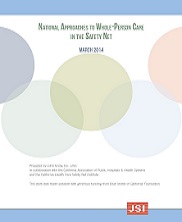An individual’s health is greatly influenced by the social and economic conditions in which they live, work, and play. Safety-net populations often experience a multitude of physical and behavioral health issues stemming from or amplified by psychosocial challenges such as housing instability, unemployment, and food insecurity, which influence access to care and health outcomes. There is a growing interest in better coordinating social services, behavioral health, health services, and public health in the safety net to create models of “whole-person care,” recognizing that vulnerable individuals often have unmet needs spanning multiple systems. For the purposes of this paper, we propose a working definition of whole-person care as the coordination of health, behavioral health, and social services in a patient-centered manner with the goals of improved health outcomes and more efficient and effective use of resources.
This White Paper is the first of two papers that seek to identify policy recommendations and next steps for advancing whole-person care for California’s vulnerable populations. This paper is based on a review of published articles and gray literature on delivery system transformation models that touch on whole-person care concepts, with focus on dual-eligible demonstrations, safety-net accountable care organizations, and Accountable Care Communities. It is supplemented by interviews with state officials and safety-net providers in nine other states and draws on preliminary research conducted in five California counties.
This White Paper is composed of five sections and introduces the reader to the concept of whole-person care through a six-dimension framework, as well as provides examples from across the nation that are promoting and implementing whole-person care approaches through various delivery system models and funding mechanisms. JSI, 2014.


